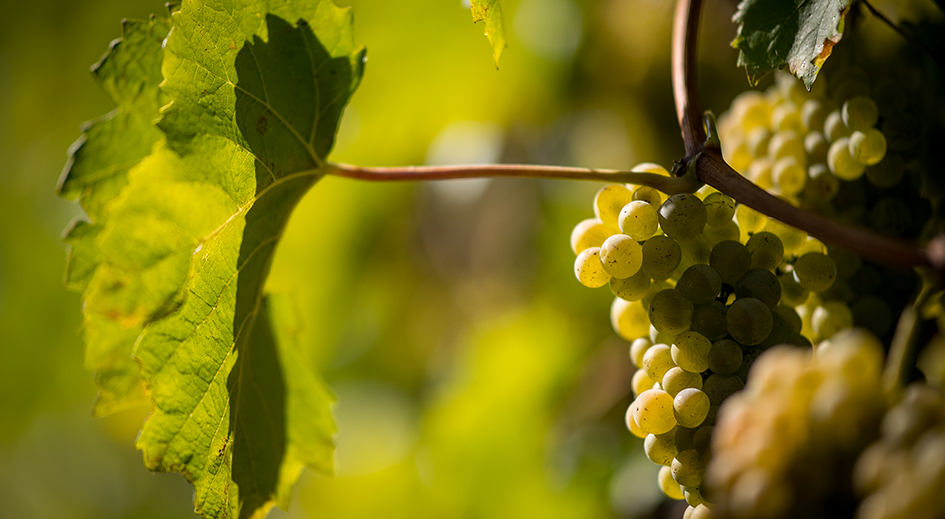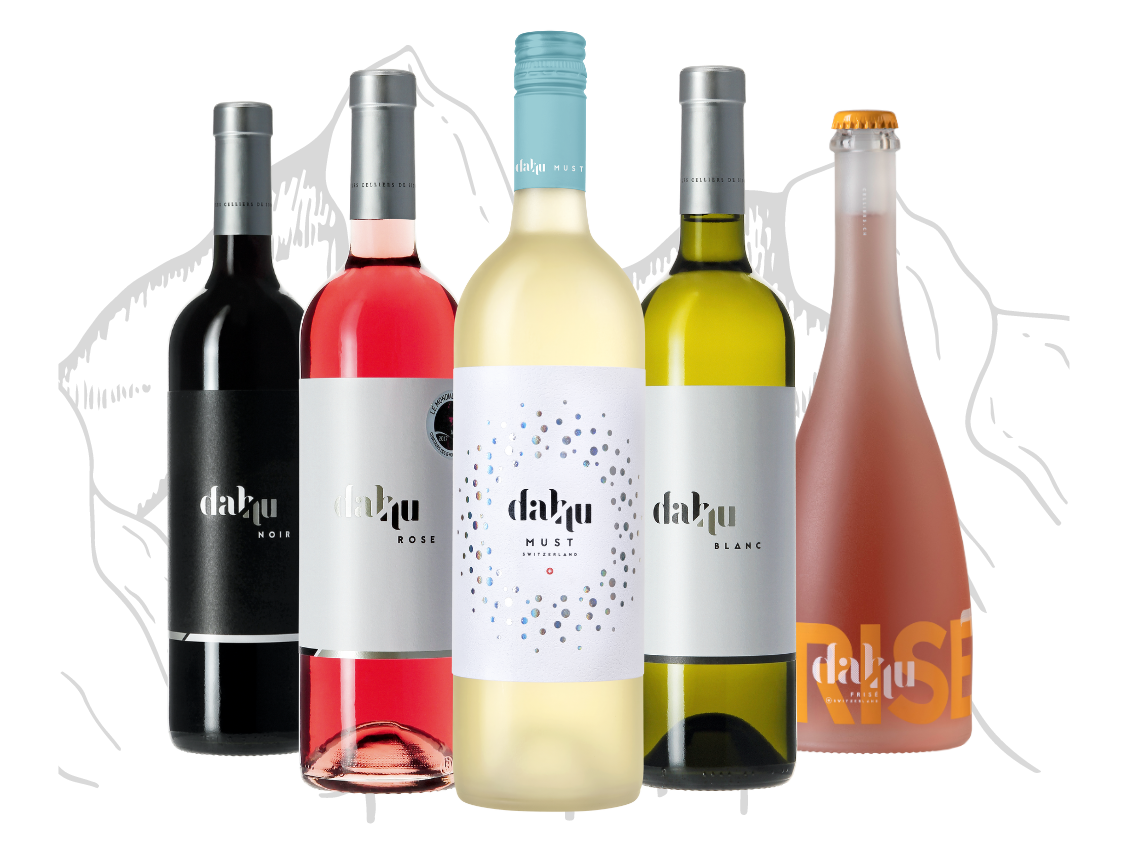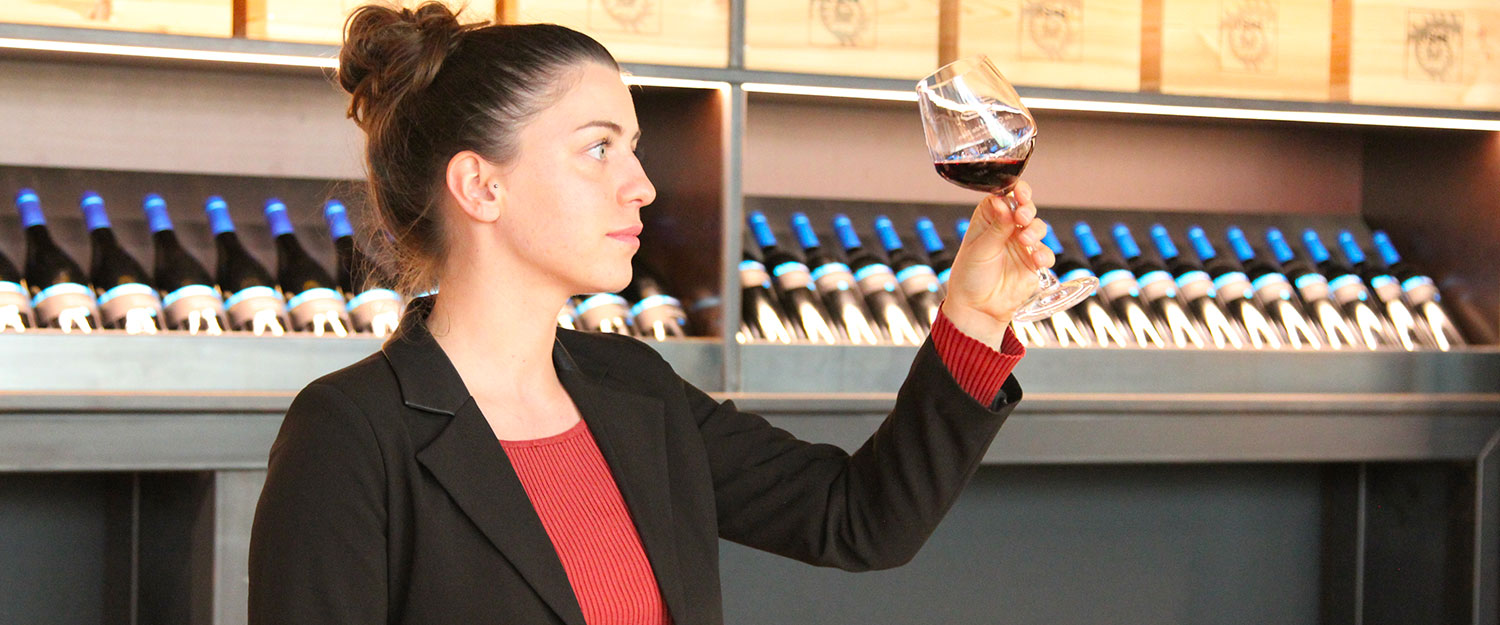In Switzerland, vines have shaped our landscape for centuries. Among these riches, the grape varieties most widely grown in Switzerland play a key role, reflecting the diversity and typicity of our country. Each wine-growing region, each variety tells a unique story, and together they weave the fabric of our oenological heritage. At Celliers de Sion, we take great pride in our contribution to this winemaking tradition, cultivating and producing wines that embody the spirit of our region: the Valais.
Switzerland’s vineyards, characterized by a great diversity of soils and climates, offer a spectacular environment wherever they are grown. From towering Alps to tranquil lakes, each wine-growing region cultivates grape varieties that are adapted to its unique characteristics.
These grape varieties are at the heart of the identity of every Swiss wine region. They are chosen not only for their ability to thrive in our climates, for their ability to express the complexity of our terroir, but also as the historical memory of Swiss vineyards.
At Celliers de Sion, we’re committed to providing you with an experience that not only introduces you to these unique flavors, but also transports you to the magnificent landscape of Sion, where these wines come to life.

Switzerland has a very wide variety of grape varieties
Although there are over 250 grape varieties in our country, the 10 most widely planted account for 80% of production.
In Switzerland, 44% of vineyards are planted with white grape varieties and 56% with red grape varieties. Surprisingly, German-speaking Switzerland as a whole is more heavily planted with red grape varieties.
Let’s discover the most widely grown grape varieties in Switzerland.
The most widely grown red grape varieties in Switzerland
3,702 ha
1,220 ha
1,050 ha
Gamaret
429 ha
Garanoir
226 ha
210 ha
163 ha
143 ha
The most widely grown white grape varieties in Switzerland
3,502 ha
409 ha
321 ha
261 ha
A historical overview of viticulture in Switzerland
Historically, Switzerland has a long tradition of winegrowing, dating back to Roman times. Today, with a surface area of close to 15,000 ha, Switzerland is a veritable wine melting pot. This variety is the fruit of centuries of adaptation and the quest for excellence.
The most common grape varieties grown in Switzerland can be divided into 4 groups:
- Native Swiss grape varieties such as Chasselas, Petite Arvine, Cornalin and Humagne rouge.
- Swiss grape varieties developed by the Swiss Federal Agricultural Research Station, such as Gamaret, Garanoir, Diolinoir, Divico or Divona.
- Traditional grape varieties introduced to Switzerland before the phylloxera crisis (before 1900), such as Pinot noir, Gamay, Merlot and Chardonnay.
- Allogeneous grape varieties, planted in Switzerland since 1900, such as Syrah, Cabernet Franc, Cabernet Sauvignon, Viognier and Sauvignon blanc.

1. Chasselas, called Fendant in Valais
Chasselas, known as Fendant in Valais, is the emblematic grape variety of Swiss vineyards. If there’s one grape variety that embodies the soul of Swiss wine, it’s Chasselas, and with good reason: more than half of all Swiss white wines are made from this variety.
History and origins of Chasselas
Long thought to originate in Egypt or the Middle East, Chasselas turns out to be a typically Swiss grape variety. In fact, according to the latest research, the origins of this emblematic grape variety of French-speaking Switzerland lie in the Lake Geneva region. In the canton of Vaud, the traditional name “Fendant blanc” was abandoned in the early 20th century in favor of village names. In Valais, where it had been massively introduced from 1848 onwards, the name “Fendant” was maintained, so much so that in 1966 the Federal Court granted exclusive use of this appellation to the only Chasselas wine produced in Valais.
Where is Chasselas grown in Switzerland?
Chasselas is the emblematic grape variety of French-speaking Switzerland. Vaud, Valais, Geneva and Neuchâtel all grow it successfully, preserving the specific characteristics of their climates and terroirs.
Taste profile and food and wine pairing
This white grape, with its delicate berries, produces light, fresh wines appreciated for their freshness, minerality and subtle floral aromas. It expresses the nuances of the terroir with finesse, which is probably why it is so popular with Swiss wine lovers. A perfect aperitif wine, it is often paired with dishes such as raclette or fondue, where its freshness balances the rich flavors of the cheese. But it can also be a wonderful accompaniment to freshwater fish or, as a true chameleon, a platter of sushi.
Its greatness lies in its ability to age when matured in the right terroirs.
2. Pinot Noir
Pinot Noir is one of the most prestigious red grape varieties. While it has acquired an international dimension in its native Burgundy, it has found a place of choice in Switzerland. No wonder it’s the most widely grown grape variety in Switzerland. In Switzerland alone, it accounts for over 30% of the area planted with red grape varieties.
Characteristics of Swiss Pinot Noir
Its ruby-red color heralds elegant wines with red fruit aromas and silky tannins. Generally vinified in vats to preserve its finesse and elegance, it can also be matured in oak barrels to add complexity. In the best terroirs, it shows depth and exceptional elegance. These wines often improve with age, developing more complex notes of undergrowth and mushrooms over time. They are the perfect accompaniment to red meats and game.
A variety with a thousand faces, it is frequently blended with Gamay, Gamaret and/or Garanoir to produce fine, pleasant wines. Particularly in the Valais, where it has earned a reputation under the appellation “Dôle”.
Key regions and winemaking methods
Pinot Noir can be found in almost every Swiss canton. Its ability to produce great wines in cool climates explains why it is appreciated throughout the country, with the exception of Ticino. While its qualities are particularly recognized in the cantons of Graubünden, Neuchâtel and Valais, it also produces outstanding wines in Schaffhausen, St. Gallen and Aargau.
It also amazes us when vinified as a rosé. It produces fine, fruity wines with delicate acidity, generally known in Switzerland and particularly in Neuchâtel as “Œil de Perdrix”. In Valais, Pinot Noir rosé is often combined with sweet-pressed Gamay to produce “Dôle blanche”.
3. Merlot
Originally from the Bordeaux region of France, Merlot has found a home of choice in the canton of Ticino. In this region, it flourishes in a milder, sunnier climate, producing rich, fruity and generous red wines. Merlot produces wines of remarkable richness and complexity. It is therefore also happily grown in the cantons of Valais, Vaud and Geneva. But its preferred climate is in the Italian-speaking part of Switzerland (south of the Alps), which alone grows 95% of the Merlot planted in Switzerland.
Distinctive characteristics of Swiss Merlot
Although in its home country it is most often blended with other grape varieties, in Ticino and the other Swiss cantons it is presented as a single variety. Its elegant cherry and plum aromas, enhanced by notes of undergrowth and ivy, as well as its intense, silky tannins, enable it to produce wines of great elegance. It is frequently aged in oak barrels, a method that gives it power and complexity.
Ticino’s winegrowers have also turned it into a unique regional specialty by making it into a white wine. Although the “Merlot blanc” grape variety does exist (a cross between Merlot noir and Folle Blanche), it is Merlot Noir that forms the basis of this Ticino specialty. This wine is a fruity, refreshing blanc de noir that goes well with risotto or grilled fish.
This grape variety is the perfect embodiment of the alliance between tradition and modernity in Swiss viticulture.
The best food and Merlot pairings
Thanks to its fullness and structure, Merlot goes perfectly with red meats, game and mature cheeses. But it’s also well-suited to Italian dishes such as polenta or pasta in all its forms.
4. Gamay
Gamay, a grape variety originally from the Beaujolais region, also plays an important role in Switzerland, particularly in the Geneva, Vaud and Valais regions. It produces light, fruity red wines with cherry and raspberry aromas. Swiss winemakers, especially in Geneva and the Côtes de l’Orbe, have made the most of this grape variety, giving it an intensity and structure worthy of great wines.
Tasting notes and wine style
Swiss Gamay is characterized by its freshness and juiciness, making it an easy-drinking wine that is often served chilled, especially in summer. It’s a perfect companion for light dishes such as charcuterie or salads.
In the Valais region, it is combined with Pinot Noir to create the nationally renowned Dôle. But it can also be enjoyed with pleasure when, still associated with Pinot Noir, it is vinified as a rosé. It is then called “Dôle blanche”.
In other cantons, it is often associated with the new Gamaret and Garanoir grape varieties. Aged in vats, it produces fruity, crisp wines. When aged in barrels, it produces structured wines with silky tannins.
Explore pairings with Gamay
Gamay is an ace at pairing food and wine. Its freshness, fruitiness and suppleness make it an ideal partner for a wide variety of dishes, from charcuterie and white meats to fatty fish and mild cheeses.
If you haven’t yet discovered Swiss Gamay, it’s never too late to be surprised by this beautiful expression of Swiss terroir.
5. Syrah
Originally from the northern Côtes-du-Rhône, Syrah (also known as Shiraz in the vineyards of the New World) has found an ideal environment in Switzerland, and more particularly in the Valais. This grape variety, typical of warm regions, produces powerful, full-bodied wines with intense aromas of black fruits, pepper and sometimes violets. It thrives in the sunny, arid terraces of our terraced vineyards.
As is traditional in Valais, Syrah is frequently vinified in vats, thus preserving its finesse and delicately peppery character. But when it comes from the best parches, this grape variety reveals all its complexity and depth, magnified by barrel ageing. Supported by the tannins and spicy aromas of the barrel (tobacco, coffee), the wine can be compared to the great vintages of this world.
Valais Syrah
In Valais, Syrah produces wines of great depth, perfect for accompanying robust dishes such as braised beef or spicy dishes. Syrah is one of those wines that surprises with its complexity and ability to age gracefully.
Syrah is often blended with other grape varieties. It adds color and structure, enriching the blend with its characteristic pepper aromas.
It’s worth noting that in its country of origin, this grape variety is referred to in the masculine form: Syrah; whereas in Switzerland, it’s referred to in the feminine form: la Syrah. An ambiguous attitude, to say the least, given this grape variety’s firm, sometimes rough tannins, but understandable if one considers the finesse and delicacy of its aromas.

6. Petite Arvine
If you haven’t yet tasted Petite Arvine, a typical Valais grape variety, it’s high time you did. This white grape produces wines of rare elegance, with floral (wisteria in bloom) and exotic fruit (pink grapefruit) aromas, often accompanied by a saline touch on the finish.
PetiteArvineis a white wine from the Valais that is steadily building an international reputation. It stands out for its liveliness and minerality, while offering a lovely roundness on the palate.
The ideal food and wine pairing with Petite Arvine
Petite Arvine wines, very invigorating when dry, are the perfect accompaniment to fish and seafood dishes.
It is also available as sweet or mellow wines. Always seductive thanks to its acidity, which gives it tone and freshness, it delights our palates with tarts and desserts.
7. Cornalin
Cornalin is one of the winegrowing treasures of the Valais. This indigenous red grape produces wines of character, with intense aromas of black cherry, plum and hints of spice.
Long forgotten, it has been enthusiastically rediscovered by Valais winemakers, who now produce wines of great complexity. Cornalin is a wine for laying down, improving with age, perfect for rustic dishes such as venison stew or stewed meats.
Vinification in vats preserves its freshness and delicate black cherry aromas. Its dark ruby color with hints of violet in its youth is a delight to the eye.
8. Humagne Rouge
Humagne Rouge is another typical Valais grape variety, appreciated for its rusticity and originality. It produces tannic red wines, with aromas of red fruit and wild herbs, and sometimes even a slightly animal touch.
It’s a wine that evokes mountain terroir and is ideal with robust dishes such as lamb or game. Humagne Rouge is a grape variety that expresses all the richness of Alpine viticulture.
9. Chardonnay
Although originally from Burgundy, Chardonnay has become well established in Switzerland, where it is often used in the production of sparkling wines, particularly in the Geneva region.
This white grape produces elegant wines with aromas of apple, pear and sometimes hazelnut. Swiss Chardonnay is often aged in barrels, giving it complexity and a silky texture. It goes perfectly with dishes such as salmon, roast poultry or mature cheeses.
10. Müller-Thurgau (Rivaner)
Müller-Thurgau is a white grape variety obtained by crossing Riesling and Madeleine Royale. Long thought to be a cross between Riesling and Sylvaner, it has been widely cultivated and marketed under the name Riesling x Sylvaner. Recent genetic research has shown that this is not the case, which is why the name has been dropped.
A fresh white wine
This white grape variety is particularly popular in the cooler regions of Switzerland, such as eastern Switzerland, as it is very early maturing.
It produces fresh, light wines with floral and fruity aromas, often marked by notes of peach and muscatel. It’s an easy-drinking wine, perfect as an aperitif or to accompany light dishes such as salads or grilled fish.
Discover the diversity of Swiss wines
If you’d like to explore the diversity of Swiss grape varieties, we urge you to look beyond the most common varieties and be surprised by the many treasures to be found in Swiss vineyards. With a little curiosity and openness, you’re sure to make some incredible discoveries!
The unique Mystery Wine experience: become a grape variety detective
Want to spice up your next wine tasting session? Discover our Mystery Winea fun, sensory experience that will put your taste buds to the test!
Dive into the world of mystery wines with our Enomatic, featuring an exclusive selection of 4 wines served blind.
Your challenge? Identify the grape varieties hidden behind the masked bottles. Whether you’re an amateur or a connoisseur, this activity is an ideal opportunity to test your oenological knowledge while having fun.

















